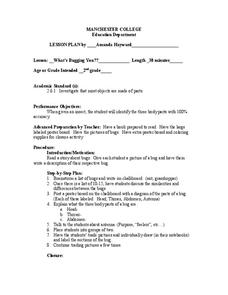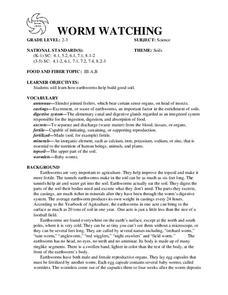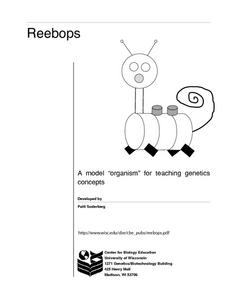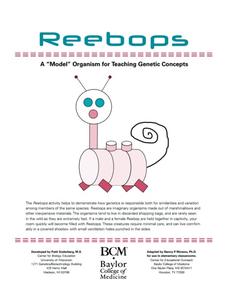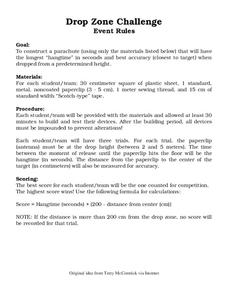Teach Engineering
Wimpy Radar Antenna
The Diary of a Wimpy Antenna? In the last installment of a six-part series, your class constructs a model of a radio antenna and tests its torque. Pupils use the results to design a better model that resists bending and twisting forces.
Curated OER
What's Bugging You?
Second graders investigate insects. In this parts of a whole, 2nd graders discuss what the three body parts of an insect are as well as the antenna. Students create their own insect labeling each body part and antenna.
Curated OER
Radio Antenna Application of the Pythagorean Theorem Problem
In this Pythagorean theorem activity, students solve one Pythagorean Theorem application problem concerned with the minimum length required for a radio antenna wire. The solution is provided by clicking on the "show solution" button at...
Curated OER
What's That You're Saying Out There?
Learners are able to demonstrate knowledge of natural and artifical satellites. They are able to demonstrate the differeence between "active" and "passive" communciation. Students are able to define radio waves, amplification reflection,...
Curated OER
Buzzing Bee's Wardrobe
Young scholars investigate the anatomy of honeybees. In this anatomy lesson, students research the physical characteristics of bees and discover what they do. Young scholars create a model of a honeybee showing the correct anatomy.
Curated OER
WORM WATCHING
Students investigate how earthworms help build good soil. They examine the worms carefully to find the ringlike segments and swollen band at the front of the earthworm's body. Students take turns dampening the soil every day and adding...
Curated OER
Introduce Vocabulary: Have You Seen Bugs? (Oppenheim)
Are your scholars interested in bugs? Get future entomologists excited about vocabulary through Joanne Oppenheim's colorful book Have You Seen Bugs? They use the informational text (although this strategy is useful for any book) to learn...
Roland Park Country School
Butterfly or Moth?
What is the main difference between a moth and a butterfly? Butterflies have club-shaped antennae, while moths have a feather-like antennae. But what else differentiates these beautiful insects? The presentation in the resource provides...
Curated OER
Reebops a Model "Organism" for Teaching Genetics Concepts
Reebops are cute, marshmallow-based creatures that can be used to teach inheritance. Beginning biologists draw strips of paper that represent chromosomes from two envelopes, one for the father, and one for the mother. Each parent...
Baylor College
Reebops: A “Model” Organism for Teaching Genetic Concepts
In a sweet simulation, junior geneticists examine the chromosomes of a fictitious Reebop marshmallow animal, combine chromosomes to produce offspring, and then make a model of the resulting Reebop baby. Phenotypes include number of...
Curated OER
Probability Exercise
Follow fruit fly genetics with this probability activity. Biology scholars analyze the alleles of Bugsy, Daisy, Dino, and Lulu, considering traits for antennae, wing type, and eye color. They solve Punnett squares to determine the...
Curated OER
Ants
Ants are a common example to use when conducting lessons on insects, and if your youngsters are squeamish, this is a way to introduce them without actually bringing them into the classroom! Viewers of this PowerPoint learn about the...
Curated OER
Torn Insect Art
Sometimes the best way to drive home a concept is through an art project. Here is a quick and easy activity that can help learners remember or become more familiar with the parts on an insect's body. They tear brightly colored paper into...
University of Colorado
The Jovian Basketball Hoop
A radio receives radio signals, converts them to an electrical signal, then converts this signal to a sound signal, and amplifies the sound so people can hear it. Class members use this information to create a short-wave radio antenna...
Curated OER
Meteor Monitor
Student's measure sporadic meteor activity. In this physics and astronomy lesson, 11th graders construct a dipole antennae, and build, test and wire a full wave diode rectifier between the dipole antenna and the laptop.
Curated OER
Insect Anatomy
In this insect worksheet, students label the parts of an insect on a diagram and then write down one fact about each of the body parts. This worksheet has 5 fill in the blank and 6 short answer questions.
Curated OER
Insect Anatomy
In this insect anatomy worksheet, students utilize a word bank to label the six parts of an insect: abdomen, antennae, head, legs, thorax and wings.
National Gallery of Canada
Transformation
Create colorful cool or warm butterflies with simple materials. Class members draw their designs, spray the marker to diffuse the colors, and attach pipe cleaners to form the shape of a butterfly with antennae. Individuals must be able...
Curated OER
Drop Zone Challenge
For this physics worksheet, students construct a parachute using the materials listed on the sheet that will have the longest and closest target when dropped from a specific height. Then they record their results after three trials.
Curated OER
Drop Zone Challenge
In this science challenge learning exercise, learners construct a parachute that will have the longest time in seconds and best accuracy when dropped from a predetermined height. Then they use the formula given to determine the...
Curated OER
Identifying Organisms
In this organisms worksheet, 9th graders look at each picture of insects and use the key at the bottom of the sheet to determine which order they belong to. Then they explain which insect is a true bug and which is a true beetle and...
Curated OER
Getting a Handle on Your Bee
Students observe dried bees, carefully glue them to toothpicks, and use them for cross pollinating their Brassica plants. They also describe reasons why two similar investigations can produce different results. Finally, students...
Curated OER
"The Aquatic Fish Foods"
In this insects worksheet, students access a website to answer questions about the different types of insects that are food for fish. This worksheet has 10 short answer questions.
Curated OER
Arthropods
In this arthropods worksheet, students complete a graphic organizer by reading characteristics of the different classes or subphylum and writing in examples for each of these groups.
Other popular searches
- Antennae Insect
- Antennas
- Antenna Math
- Antenna and Wave Propagation
- Antenna System
- About Smart Antenna
- About Samrt Antenna
- Antenna and Wave Probagation
- Simple Macchine With Antenna
- Parabolic Antenna
- Insect Eyes and Antennas
- Repeater Antennas



